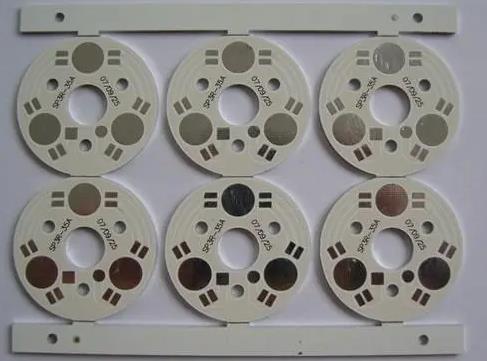Aluminum based copper clad laminate is a metal-based copper-clad laminate with good heat dissipation function. It generally consists of a three-layer structure of circuit layer (copper foil), insulation layer and metal base layer.
It generally consists of a three-layer structure of circuit layer (copper foil), insulation layer and metal base layer. LED lighting products. There are two sides, the white side is soldered with LED pins, and the other side is aluminum-colored. It is usually in contact with the heat-conducting part after being coated with thermal paste. There are also ceramic substrates, etc.
The high-end use of aluminum-based copper-clad laminate is also designed as a double-sided board with a structure of circuit layer, insulation layer, aluminum base, insulation layer and circuit layer. Multilayer board design are rarely used and can be composed of ordinary multilayer boards, insulation layers and aluminum bases. LED aluminum-based circuit board is PCB, which also means printed circuit board, but the material of the circuit board is aluminum alloy. In the past, our general circuit board material was fiberglass, but because LEDs generate a lot of heat, the circuit boards used in LED lamps are usually aluminum-based circuit boards, which conduct heat quickly. Circuit boards used in other devices or appliances are fiberglass boards.
Aluminum-based circuit boards (aluminum-based circuit boards, copper substrates, iron substrates) are low-alloyed Al-Mg-Si high-plasticity alloy plates (see the structure below) with good thermal conductivity, electrical insulation and mechanical processing efficiency. Compared with traditional FR-4, aluminum-based circuit boards have the same thickness and line width, and can withstand higher currents. The withstand voltage of aluminum-based circuit boards can reach 4500V, and the thermal conductivity is greater than 2. Aluminum-based circuit boards are mainly used in industries.
●Adopt surface mount technology(SMT);
●Thermal diffusion is handled very effectively in circuit design;
●Reduce product operating temperature, improve product power density and reliability, and extend product service life;
●Reduce product volume and reduce hardware and assembly costs;
●Replace fragile ceramic substrates to achieve better mechanical durability.

Aluminum circuit board
Aluminum based copper clad laminate is a metal circuit board material composed of copper foil, thermally conductive insulation layer and metal substrate. Its structure is divided into three layers:
1. Circuit Layer: equivalent to ordinary PCB copper clad laminate, the thickness of the wire copper foil is from loz to 10oz.
2. Dielcctric Layer insulation layer: The insulation layer is a low thermal resistance thermally conductive insulating material. Thickness: 0.003” to 0.006” inches is the core technology of aluminum-based copper clad laminate, which has obtained UL certification.
3. Base Layer: metal substrate, usually aluminum or copper. Aluminum based copper clad laminate and traditional epoxy glass cloth laminate.
The aluminum-based copper-clad laminate used in aluminum-based circuit boards has unparalleled advantages compared with other materials. Suitable for surface mounting SMT of power components. There is no radiator, the volume is greatly reduced, the heat dissipation effect is good, the insulation performance is good, and the mechanical performance is good.
The LED crystal substrate board is the main heat transfer medium between the LED circuit board and the system circuit board and is combined with the LED die through wire bonding, eutectic or flip chip processes. Based on heat dissipation considerations, LED crystal substrates on the market are mainly ceramic substrates, which can be divided into thick-film ceramic substrates, low-temperature co-fired multi-layer ceramics and thin-film ceramic substrates. Traditional high-power LED components are based on thick-film or low-temperature co-fired ceramic substrates. heat dissipation substrate, and then use gold wire LED chips to combine with the ceramic substrate. As mentioned in the introduction, gold wire connections limit the efficiency of heat dissipation along the electrode contacts. Circuit board manufacturers are working hard to solve this problem. There are two solutions. One is to look for substrate materials with high heat dissipation coefficients to replace alumina, including silicon substrates, silicon carbide substrates, anodized aluminum-based circuit boards or aluminum nitride-based circuit boards. The material transistor characteristics of silicon and silicon carbide substrates make them face strict testing at this stage. However, anodized aluminum-based circuit boards are prone to cracks due to insufficient strength of the anodized oxide layer and have limited practical applications. Therefore, at this stage, aluminum nitride is mature and widely accepted as a heat dissipation substrate; however, aluminum nitride-based circuit boards are not suitable for traditional thick film processes (after silver glue printing, the material must be atmospherically heat treated at 850°C, resulting in data reliability question). For this reason, aluminum nitride-based circuit board circuits should be prepared using thin film technology. The aluminum nitride-based circuit board is prepared using a thin film process, which greatly accelerates the efficiency of the thermal LED grain from the substrate material to the system circuit board and greatly reduces the burden of the thermal LED grain from the metal wire to the circuit board, thereby achieving the effect of high heat dispersion.